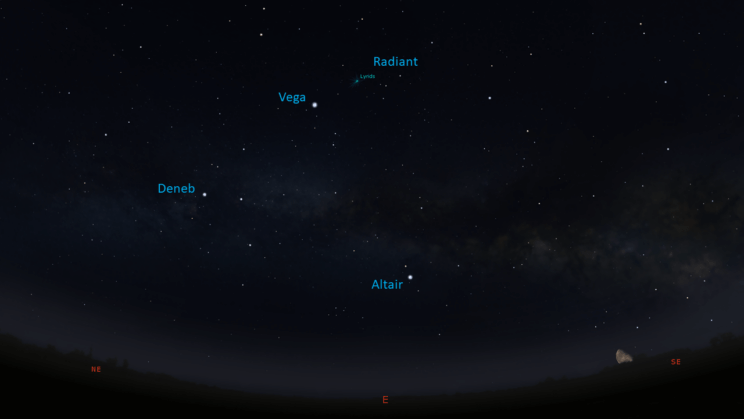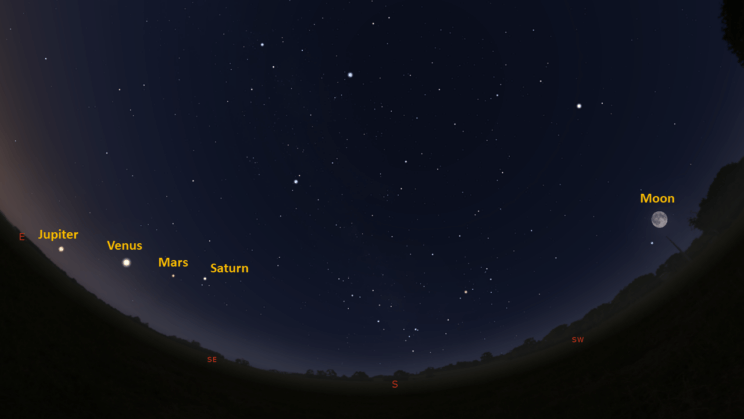This is the Saint Louis Science Center’s NIGHT SKY UPDATE for the week of Friday, April 15, 2022.
Information updated weekly or as needed.
Times given as local St. Louis time which is Central Daylight Time (CDT). For definitions of terminology used in the night sky update, click the highlighted text. If relying on times posted in Universal Time (UT), St. louis is -5 hours when CDT.
Public Telescope Viewings
With the changing recommendations from the CDC regarding COVID-19, conversations regarding the return of star parties at the Saint Louis Science Center have begun. We are close to bringing back our public telescope viewings, but a few details still need to be worked out. We will post future updates as we learn more about when we can bring back telescope viewings.
Observing Highlight of the Week

Location of the Lyrid radiant at 2:00 a.m. on April 22, 2022.. Image created using Stellarium
On April 21, 2022, the annual Lyrid meteor shower occurs. This happens every year as Earth passes through debris from comet C/1861 G1 (Thatcher). As meteor showers go, the Lyrids is a moderate one most years but is does periodically have years of outburst activity.
What causes a meteor shower is debris from comets or in a few cases asteroids. When comets approach perihelion, they heat up and the ice in the comet begins to sublimate. During this process, debris trapped in the comet is released along a path the follows the comet’s path around the Sun. If this is close to Earth’s orbit, we pass through the debris field causing a meteor shower.
Meteors are the result of a solid particle from space entering Earth’s atmosphere. As this occurs, the particle is vaporized causing a bright streak of light. The color of light seen is determined by the elements in the particle.
The comet that causes the Lyrid meteor shower is named C/1861 G1 (Thatcher). This long period comet takes roughly 415 years to orbit the Sun. It last reached perihelion on June 3, 1801 and will return in the year 2283. Each time it orbits the Sun, it deposits a fresh stream of debris that Earth will eventually pass through.
Observing a meteor shower is simple if you know two things. First, you need to know when the shower is active including its peak date of activity. Second, you will need to know where the shower’s radiant is located. A radiant is the spot in the sky that meteors appear to emanate from. This doesn’t mean every meteor comes from the one spot in the sky but rather they appear to if you trace the path of the meteor. The occurs because objects appearing to travel along parallel paths, will appear to converge in one spot in front of you. Same thing occurs when you drive into a snowstorm.
The Lyrids are active from April 14 to April 30 each year with peak activity usually on April 21-22. While the shower is active you have a chance to see meteors, but activity remains low until the peak date. The timing of the peak favors the eastern hemisphere so this year is not expected to be the best for us, but the Lyrids are known to have outburst years that can see rates increase to 90 or 100 meteors per hour. This year is not expected to be an outburst year, but it is still worth keeping an eye on the sky. Most expect this year to produce the normal 10 to 20 meteors per hour.
The radiant for the Lyrids is located near the bright star Vega in the constellation Lyra. The radiant is found about 7° east of Vega in the constellation Hercules. The Lyrid radiant should clear most tree lines by 11:30 p.m. on April 21, 2022. At this time, you will see a diminished rate of meteors because the radiant is low to the horizon. By 4:00 a.m. on April 22, 2022, the radiant will be seen high in the east. Between 2:00 and 4:00 a.m. will be an ideal time to look for meteors.
Lastly, the Moon will be exhibiting a waning gibbous phase with 62% of the lunar disk illuminated. The bright Moon along with light pollution will greatly impact how many meteors you see.
The Sun and Moon

The Moon as seen from the International Space Station, on July 31, 2011.
Credit: NASA
Sunrise is at 6:24 a.m. on Friday, April 15 and sunset is at 7:38 p.m. providing us over 13 hours of daylight. Even after sunset, the light from the Sun will dimly illuminate our sky for roughly 1 hour and 40 minutes. This period is called twilight, which ends around 9:13 p.m. this week. For those with a sundial, local noon occurs around 13:00 p.m. this week.
| Day | Sunrise | Sunset |
|---|---|---|
| 2022-04-15 | 6:24 a.m. | 7:38 p.m. |
| 2022-04-16 | 6:23 a.m. | 7:38 p.m. |
| 2022-04-17 | 6:22 a.m. | 7:39 p.m. |
| 2022-04-18 | 6:20 a.m. | 7:40 p.m. |
| 2022-04-19 | 6:19 a.m. | 7:41 p.m. |
| 2022-04-20 | 6:17 a.m. | 7:42 p.m. |
| 2022-04-21 | 6:16 a.m. | 7:43 p.m. |
| 2022-04-22 | 6:15 a.m. | 7:44 p.m. |
| 2022-04-23 | 6:13 a.m. | 7:45 p.m. |
Moon
Moonrise for Friday, April 15 occurs at 6:37 p.m. and moonset will occur at 6:28 a.m. on the following day. On Friday, April 15, the Moon will exhibit a waxing gibbous phase with 98% of the lunar disk illuminated. Full Moon for April occurs on April 16, 2022, at 1:55 p.m.
International Space Station (ISS) Observing

Visible passes of ISS from St. Louis for the week of April 15 occur during morning hours. The best pass occurs on the morning of April 23. Use the table below for information about this and other visible passes this week.
Catch ISS from St. Louis starting Friday, April 15
| Date | Starts | Max. altitude | Ends | |||||||
|---|---|---|---|---|---|---|---|---|---|---|
| Time | Alt. | Az. | Time | Alt. | Az. | Time | Alt. | Az. | ||
| 21 Apr | -1.3 | 05:42:41 | 10 | S | 05:45:06 | 19 | SE | 05:47:31 | 10 | E |
| 22 Apr | -0.8 | 04:56:10 | 10 | SE | 04:56:45 | 10 | SE | 04:57:21 | 10 | ESE |
| 23 Apr | -3.3 | 05:41:14 | 10 | SW | 05:44:29 | 59 | SE | 05:47:47 | 10 | ENE |
Magnitude (Mag): The Measure of brightness for a celestial object. The lower the value is, the brighter the object will be.
Altitude (Alt): The angle of a celestial object measured upwards from the observer’s horizon.
Azimuth (Az): The direction of a celestial object, measured clockwise from an observer’s location with north being 0°, east being 90°, south being 180° and west being 270°.
For information about ISS flyovers and other visible satellites, visit www.heavens-above.com
Detailed information regarding all unmanned exploration of our universe, missions past, present, and planned, can be found at Jet Propulsion Laboratories:
The Visible Planets

Looking south at 5:30 a.m. April 16, 2022. Credit: Stellarium, EG
This week, four naked eye planets are visible. Venus, Mars, Jupiter and Saturn are seen in the east and southeast before sunrise.
Venus
Venus has started a morning apparition and will be seen in the southeast before sunrise. Venus rises at 4:40 a.m. and should be easy to spot in the southeast by 5:30 a.m. The current morning apparition lasts until the third week of October 2022. Venus reaches superior conjunction on October 22, 2022.
Mars
A new apparition for Mars has begun. Mars rises at 4:17 a.m. Start looking for Mars around 5:00a.m. as it clears trees and buildings. Mars will continue to climb out of the Sun’s glare as it heads towards opposition later this year on December 7, 2022.
Jupiter
Jupiter is beginning to climb out of the Sun’s glare about 30 minutes before sunrise. Those with a clear view of the east may catch a view of Jupiter around 5:54 a.m. Jupiter will become much easier to see by May 2022. Jupiter reaches opposition on September 26, 2022. As we approach this date, Jupiter will become visible earlier each night.
There will be a nice pairing of Jupiter, Venus and the Moon later this month on April 27, 2022. This will be followed be a close pairing of Venus and Jupiter on April 30 and May 1, 2022.
Saturn
Saturn rises at 3:55 a.m. Start looking for Saturn around 5:00 a.m. in the southeastern sky. Saturn will reach opposition on August 14, 2022. As we head to this date, Saturn will rise earlier each day.
James S. McDonnell Planetarium
Night Sky Update: April 15 – April 23, 2022






